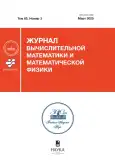MATHEMATICAL RECONSTRUCTION OF SIGNALS AND IMAGES USING TEST TRIALS: A NON-BLIND APPROACH
- 作者: Novikov-Borodin A.V.1
-
隶属关系:
- Institute for Nuclear Research (INR), Russian Academy of Sciences
- 期: 卷 65, 编号 3 (2025)
- 页面: 401-414
- 栏目: Computer science
- URL: https://ogarev-online.ru/0044-4669/article/view/293548
- DOI: https://doi.org/10.31857/S0044466925030135
- EDN: https://elibrary.ru/HSZMXU
- ID: 293548
如何引用文章
详细
作者简介
A. Novikov-Borodin
Institute for Nuclear Research (INR), Russian Academy of Sciences
Email: novikov.borodin@gmail.com
Moscow, Russia
参考
- Kazufumi I., Bangti J. Inverse Problems: Tikhonov Theory and Algorithms. Singapore: World Scientific, 2014.
- Mueller J.L., Siltanen S. Linear and Nonlinear Inverse Problems with Practical Applications. SIAM, vol. 10, 2012.
- Hansen P.C. Discrete Inverse Problems: Insight and Algorithms. Fundamentals of Algorithms. Philadelphia: SIAM, 2010.
- Kaipio J., Somersalo E. Statistical and computational inverse problems. N.Y.: Springer, 2010.
- Hespanha J.P. Linear System Theory. Princeton university press, 2009.
- Dominguez A. A History of the Convolution Operation. IEEE Pulse. V. 6(1): 38–49, 2015.
- Sobolev V.I. Convolution of functions, Encyclopedia of Mathematics. EMS Press, Helsinki, 2001.
- Vladimirov V.S. Equations of Mathematical Physics. M.: Nauka, 1981; Dekker, New York, 1971.
- Liu X., Wu Z., Wang X. The validity analysis of the non-local mean filter and a derived novel denoising method. Virtual Reality & Intelligent Hardware 2023. 5(4): 338–350.
- Wang H. et al. Ambulatory ECG noise reduction algorithm for conditional diffusion model based on multi-kernel convolutional transformer. The Review of scientific instruments. 2024. 95(9): 95–107.
- Guo X., Liu F., Tian X. Gaussian noise level estimation for color image denoising // J. Opt. Soc. Am. A, 2021. 38(8): 1150–1159. https://doi.org/10.1364/josaa.426092
- Chan T.F., Wong C.K. Total variation blind deconvolution // IEEE transactions on Image Processing, 1998. 7(3): 370–375.
- Levin A., et al. Understanding and evaluating blind deconvolution algorithms. 2009 IEEE conference on computer vision and pattern recognition, IEEE, 2009.
- Almeida M., Figueiredo M. Blind image deblurring with unknown boundaries using the alternating direction method of multipliers. 2013 IEEE International Conference on Image Processing, IEEE, 2013.
- Junjie T. A.O., et al. An image defocus deblurring method based on gradient difference of boundary neighborhood. Virtual Reality & Intelligent Hardware, 5(6): 538–549, 2023. doi: 10.1016/j.vrih.2023.06.008
- Schuler C. J., Hirsch M., Harmeling S., Scholkopf B. Learning to deblur. IEEE transactions on pattern analysis and machine intelligence, 38(7): 1439–1451, 2015. doi: 10.1109/TPAMI.2015.2481418
- Kupyn O., et al. Deblurgan: Blind motion deblurring using conditional adversarial networks. Proceedings of the IEEE conference on computer vision and pattern recognition, 2018.
- Jung Y., Jim Kong J., Bin Sheng B., Kim J. A Transfer Function Design for Medical Volume Data Using a Knowledge Database Based on Deep Image and Primitive Intensity Profile Features Retrieval // Journal of Computer Science and Technology, 2024. 39(9): 320–335.
- Li J., et al. DSMT-Net: Dual Self-Supervised Multi-Operator Transformation for Multi-Source Endoscopic Ultrasound Diagnosis. IEEE Transactions on Medical Imaging, 2024. 43(1): 64–75. doi: 10.1109/TMI.2023.3289859.
- Malay I. Digital Signal Processing in Modern Radio Engineering Measurements. Plenary Talk at XXV International Conference Digital Signal Processing and Its Applications – DSPA-2023, 2023.
- Tikhonov A. N., Arsenin, V. Y. Solutions of Ill-Posed Problems. New York: Winston, 1977.
- Elsayed M.A., El-Shafai W., Rashwan M.A., Dessouky M.I., El-Fishawy A.S., Abd El-Samie F.E. Efficient iterative implementation of regularized solutions for image and signal reconstruction problems // J. of Optics, 2023. doi: 10.1007/s12596-023-01179-w
- Xiao Z., Fang H., Tomasin S., Mateos G., Wang X. Joint Sampling and Reconstruction of Time-Varying Signals Over Directed Graphs. IEEE Transactions on Signal Processing, 2023. 71: 2204–2219. doi: 10.1109/TSP.2023.3284364
- Novikov-Borodin A.V. Test Methods for Signal Reconstruction of Linear Stationary Systems // Journal of Communications Technology and Electronics, 2023. V. 68(7): 732–747. doi: 10.1134/S1064226923070082
- Novikov-Borodin A.V. Reconstruction and simulation of experimental data using test measurements. Instruments and Experimental Techniques, 2022. 2: 43–51. doi: 10.1134/S0020441222020166
补充文件









